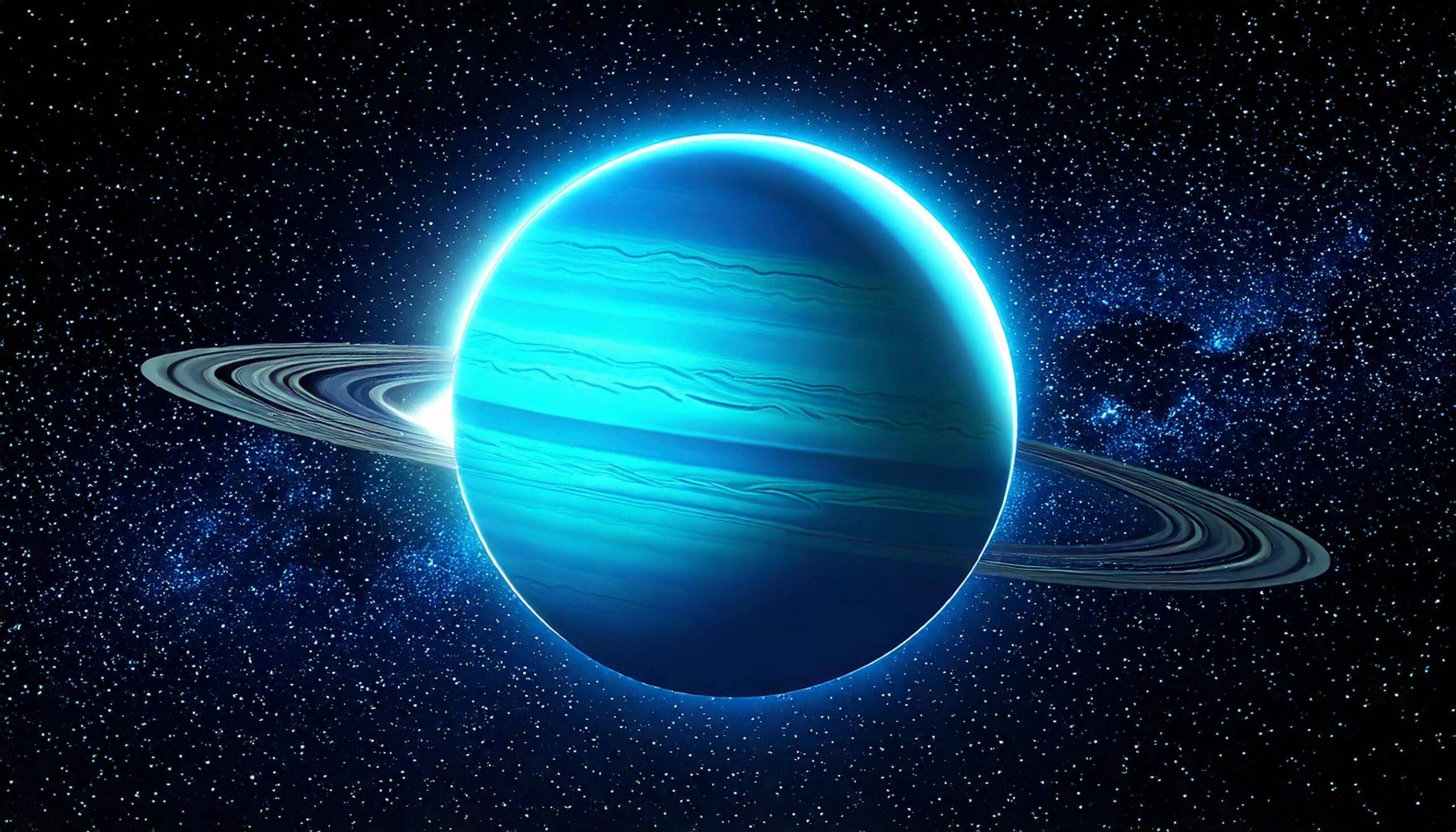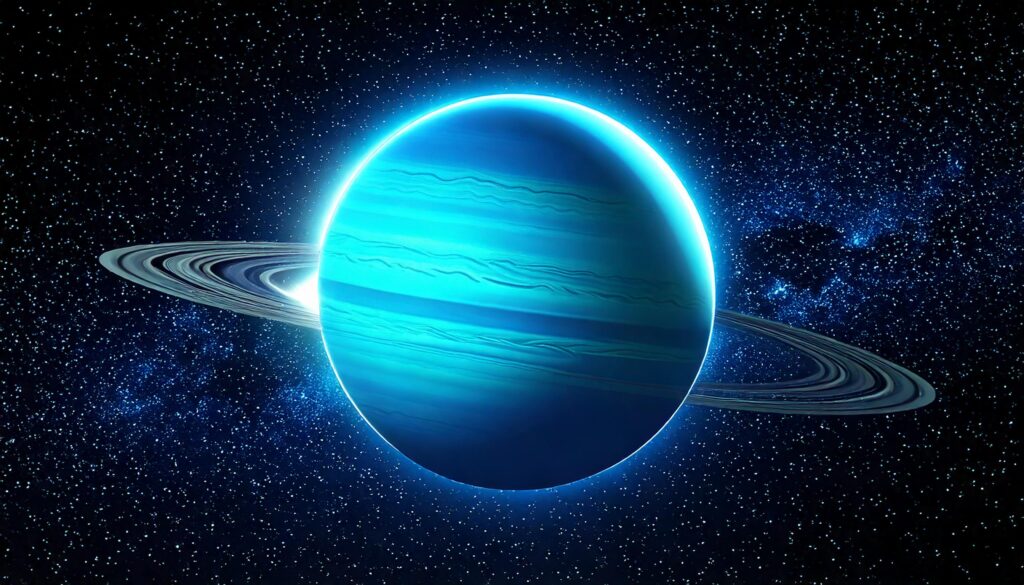
Discovering Uranus in the Classroom: A Hands-On AR & AI Journey
Oct 29, 2024

The “Uranus Exploration with AR & AI” project provides teachers with a practical, engaging way to introduce students to one of the most unique planets in our solar system. Using just a Windows or Mac computer with a webcam and connecting it to a projector, TV, or smart board, teachers can create an interactive learning experience that brings Uranus’ fascinating characteristics right into the classroom. Students will explore this "ice giant" through immersive AR visuals and AI-driven narration, from its striking blue-green atmosphere to its extreme tilt, which leads to unusual seasons and long years. It is free for the teachers to use in the classrooms.
Each stage in this free resource is structured to help students grasp complex scientific concepts in an accessible, engaging way. From understanding Uranus’s position in the solar system to observing how its dramatic tilt affects its seasons, this project aligns with NGSS standards and encourages students to think critically about planetary science. The following guide outlines each stage and provides activity ideas and classroom tips to make learning about Uranus both impactful and memorable. Download the project today to start exploring Uranus with your students, fostering curiosity and building a strong foundation in space science.
Instruction Guide
Introduction to the Project:
- Stage 1: Meet Uranus - Introduce Uranus, discussing its position in the solar system, its size, and why it’s called an “ice giant.”
- Stage 2: Uranus' Atmosphere and Composition - Explore Uranus’s atmosphere and the unique blue-green color it gives the planet, emphasizing its cold temperatures and icy layers.
- Stage 3: Rotation and Tilt - Highlight Uranus’s unusual rotation and extreme tilt, which causes extended seasons and a unique sideways spin.
- Stage 4: Reflection and Review - Recap key learning points about Uranus, including its icy atmosphere, cold temperatures, and unique rotation, allowing students to reflect on their favorite discoveries.
Each stage uses narration and interactive activities to guide students through their exploration of Uranus, fostering curiosity, critical thinking, and hands-on engagement.
Learning Objectives and Outcomes
Learning Objectives with NGSS Standards Alignment:
- Understand Uranus’ Position, Size, and Orbital Characteristics
- Objective: Students will learn that Uranus is the seventh planet from the Sun, exploring its large size and lengthy orbital period, which results in an 84-year-long “year.”
- NGSS Alignment: ESS1.B: Earth and the Solar System - Develop an understanding of planetary orbits, sizes, and distances in the solar system.
- NGSS Code: 5-ESS1-2 - Represent data to show patterns in planetary characteristics like size and orbital period, comparing Uranus to Earth.
- Explore Uranus' Atmosphere and Composition
- Objective: Students will investigate Uranus’s atmosphere, which contributes to its unique color, and examine how it influences the planet’s extreme cold.
- NGSS Alignment: PS1.A: Structure and Properties of Matter - Explore how matter, including gases and ices, composes planetary atmospheres.
- NGSS Code: 5-PS1-1 - Develop a model to describe that matter is made of particles too small to be seen, understanding how these particles create Uranus’s atmosphere and icy composition.
- Understand Uranus's Rotation and Tilt and Its Effect on Seasons
- Objective: Students will observe how Uranus’s 98° tilt affects its rotation and seasons, learning that each Uranian season lasts 21 Earth years.
- NGSS Alignment: ESS1.B: Earth and the Solar System - Understand how a planet’s tilt affects day and night patterns and seasonal variations.
- NGSS Code: 5-ESS1-2 - Represent data in graphical displays to reveal patterns of daily changes and seasonal appearances, with a focus on Uranus’s unique axial tilt.
Learning Outcomes:
- Outcome 1: Students can summarize Uranus’s characteristics, such as its position, size, and the reasons it’s known as an “ice giant.”
- Outcome 2: Students can discuss Uranus’s atmosphere and extreme tilt, understanding how these factors affect its temperature and seasons.
- Outcome 3: Students use scientific vocabulary aligned with NGSS and Common Core standards to describe Uranus’s environmental features and orbital characteristics.
Classroom Activity Design
Pre-AR Project Activities (Warm-Up & Background Building)
- Planetary Comparison Warm-Up
- Objective: Introduce students to the concept of “ice giants” and compare Uranus with Earth.
- Activity: Use a chart to compare and contrast Earth and Uranus by matching characteristics like “blue-green color,” “extremely cold,” and “long seasons.”
- Outcome: Provides context for Uranus’s features and sets the stage for understanding its distinct environment.
- Understanding Tilt Basics
- Objective: Help students grasp the concept of planetary tilt.
- Activity: Use a globe to demonstrate Earth’s tilt and then tilt it dramatically to represent Uranus. Ask, “How might a big tilt change the seasons?”
- Outcome: Prepares students to understand how Uranus’s 98° tilt affects its rotation and seasons.
Post-AR Project Activities (Reinforcement & Hands-On Learning)
- Uranus Reflection Journal
- Objective: Encourage students to reflect on what they learned about Uranus’s tilt, atmosphere, and temperature.
- Activity: Students write a short entry or draw about Uranus’s characteristics, such as its icy atmosphere or extended seasons.
- Example Prompts:
- "Why is Uranus called an 'ice giant'?"
- "Describe how Uranus’s tilt affects its seasons."
- Outcome: Reinforces key facts and allows students to summarize their understanding of Uranus.
- Temperature and Distance Comparison Activity
- Objective: Help students visualize the extreme cold of Uranus compared to other planets.
- Activity: Create a simple chart where students match planets (e.g., Earth, Jupiter, Uranus) with average distances from the Sun and temperatures. Discuss why Uranus is so cold.
- Outcome: Reinforces understanding of planetary temperatures and the relationship with distance from the Sun.
- Tilt and Season Simulation
- Objective: Demonstrate how Uranus’s tilt affects its seasonal patterns.
- Activity: Use a tilted ball or sphere to represent Uranus and a lamp for the Sun, showing how one hemisphere remains in light while the other remains in darkness.
- Outcome: Allows students to visualize Uranus’s unique seasonal patterns due to its extreme tilt.
Classroom Management Tips
- Clear Viewing: Arrange seating so all students have a clear view of the AR project screen or display to remain engaged during the exploration.
- Rotate Participation: Ensure all students have the opportunity to engage in interactive portions by rotating turns.
- Pre-Prepared Responses: Help students prepare for questions, especially about Uranus’s tilt and seasons, to build their confidence in participating.
- Positive Reinforcement: Acknowledge students’ efforts with praise to encourage active engagement.
- Turn-Taking: Monitor participation to ensure all students get an opportunity to engage with the AR project, especially for unique interactive activities.
Formative Assessments
- Uranus and Earth Comparison Activity
- What It Is: A simple matching activity where students identify features unique to Uranus, such as its extreme tilt and “ice giant” status, in comparison to Earth.
- Purpose: Reinforces comprehension of Uranus’s unique features by contrasting them with Earth.
- Reflection Journal Entry
- What It Is: After the AR experience, students write or draw about what makes Uranus unique, including its temperature, tilt, and atmosphere.
- Example Prompts:
- "What makes Uranus different from other planets?"
- "Why does Uranus have such a long year?"
- Purpose: Allows students to summarize their understanding and reinforces learning.
- Tilt and Season Simulation Reflection
- What It Is: After the tilt simulation, ask students to describe how Uranus’s extreme tilt causes long seasons.
- Purpose: Reinforces understanding of how planetary tilt affects seasons, especially for planets like Uranus.
Cross-Subject Integration Suggestions
- Math: Calculate Uranus’s orbit time and compare it to Earth’s, discussing what it means to have a year that lasts 84 Earth years.
- Art: Have students draw Uranus with its unique blue-green color and show how it might appear with one hemisphere in continuous light.
- Language Arts: Write a paragraph describing Uranus’s environment and tilt, using vocabulary like “ice giant,” “atmosphere,” and “tilt.”
- Social Studies: Discuss the Voyager missions and other exploratory missions that provided images and data about Uranus, giving context to planetary exploration.

